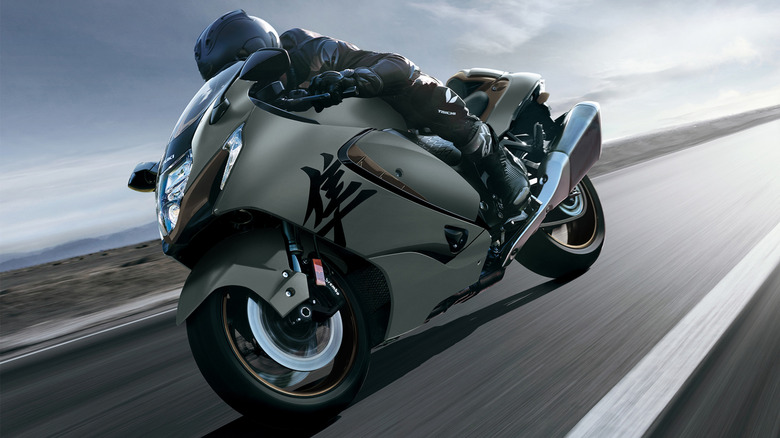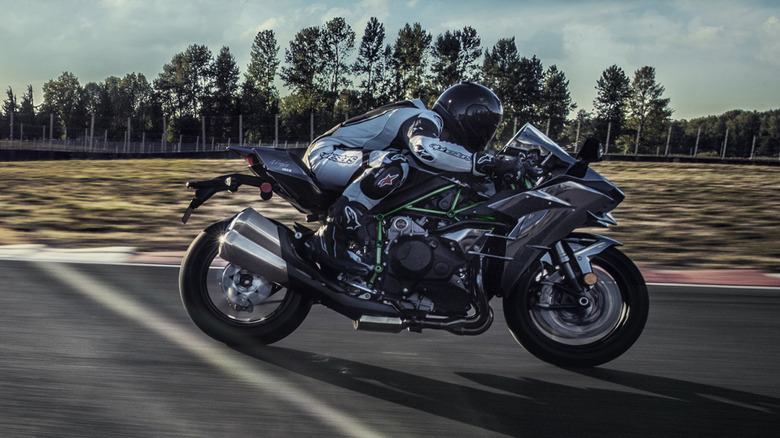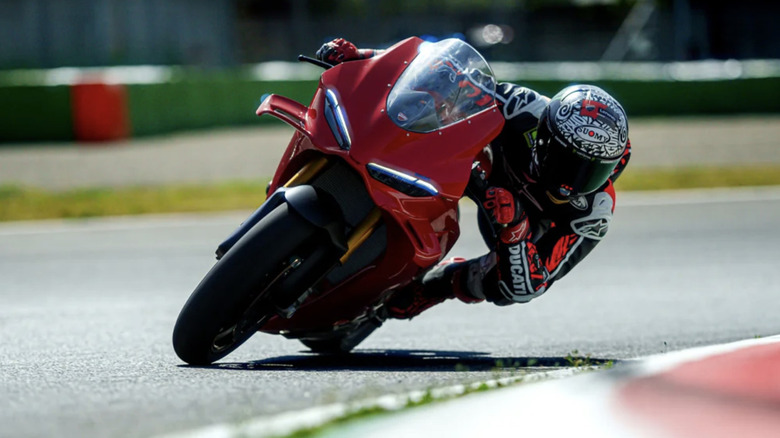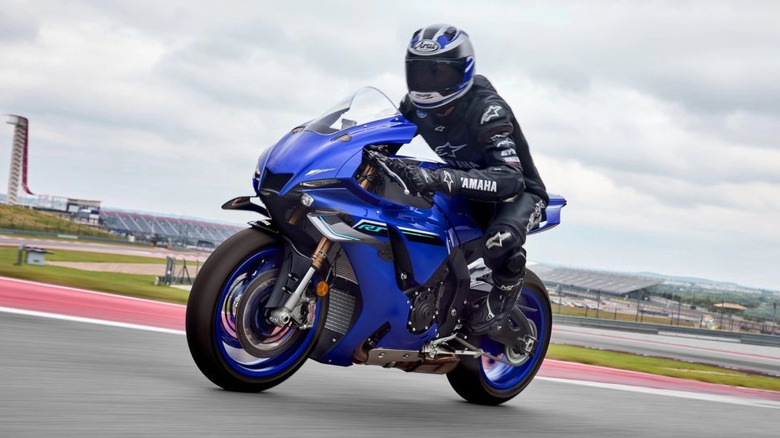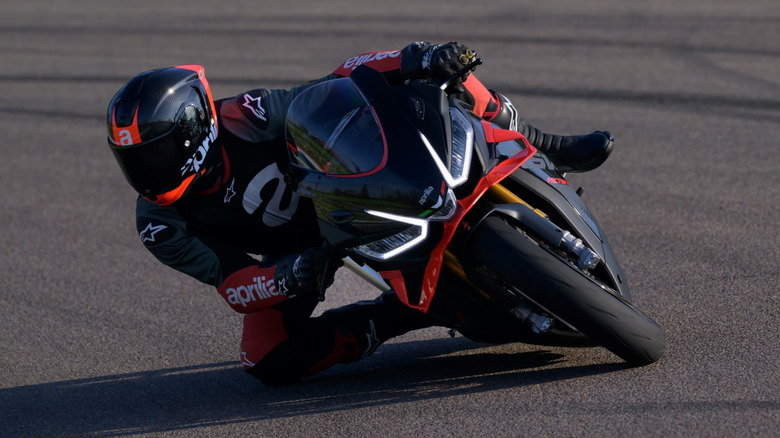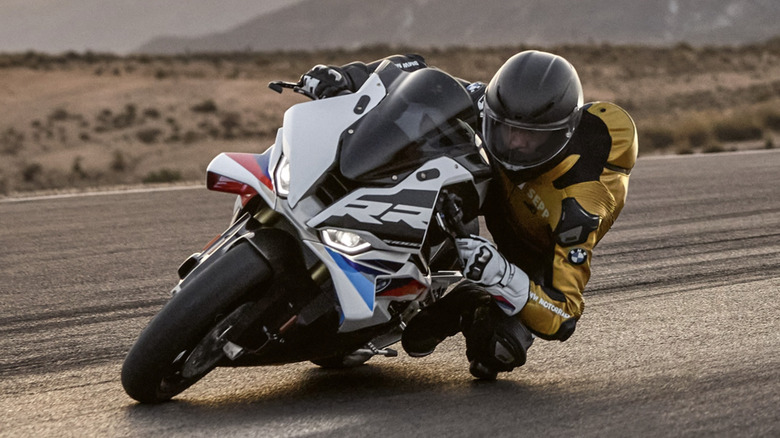5 Motorcycles That Rival The Suzuki Hayabusa's Legendary Speed
The Hayabusa is one of the most well-known names in the motorcycle world. The big Suzuki supersport bike is known for making astonishing power and providing the sort of speed that frightens away beginner riders (or at least it should). The current third-generation Hayabusa is powered by a larger-than-average 1,340cc four-cylinder engine that produces 187 horsepower and 110.6 lb-ft of torque (190PS and 150Nm according to Suzuki U.K.).
That's enough power to launch it from zero-to-60 mph in just 3.2 seconds – Suzuki's professional riders have done it in as little as 2.6 seconds. Oh, and let's not forget the top speed of 186 mph. Like other ultra-high-performance sport bikes, the Hayabusa is limited to 186 mph (299 kph) as a part of the motorcycle Gentlemen's Agreement, but even early testing models topped out well above 200 mph.
The Hayabusa, though, is not alone. The first Hayabusa was released over 25 years ago and while it has had some updates to keep it modern, the sport bike world didn't stand still around it. Several manufacturers currently make bikes that can keep up with or even outpace the Busa, with some coming in the liter bike category, some offering Busa-sized displacement, and others even offering forced induction. These bikes aren't cheap, though. The 2025 Hayabusa has an MSRP of $19,999 (including $600 destination fee) so if you're looking for that range-topping speed, be sure to have a supportive pep talk with your wallet before heading to the dealership.
Kawasaki H2 (in its many forms)
One of the best candidates for a rivalry with the Hayabusa is the Kawasaki H2. The H2's powerplant is a rowdy 998cc inline-four cylinder engine paired with a supercharger. The standard H2 produces 239.6 hp and 104.9 lb-ft of torque. That's more than enough power to keep pace with the Busa, but with the H2, there are a lot of other versions of the supercharger-sporting bike available to spice things up. The H2 SX SE offers the same powerplant, but tuned less aggressively and aimed at more comfortable riding scenarios. Still, the SX SE puts out 207 hp and 101 lb-ft.
Then, of course, there's the race-only, limited-production H2R which ignores pretty much every rule of the road (and defies a few laws of physics too) with 321.5 hp and 121 lb-ft. That's almost double the power of the Hayabusa and the H2R weighs less too — just 476 pounds wet, according to Kawasaki. The Busa tips the scales at 582 pounds, showcasing the weighty result of larger displacement.
With the H2R's $60k starting price and its limited availability, it's better to focus on the standard H2 as a rival to the Hayabusa. The msrp for the H2 ABS is still higher than the Busa though at $33,515. The naked version of the H2, the Z H2, is a bit closer still with an MSRP of $22,515, but its straight-line speed will likely be affected by its lack of aerodynamic body work.
Ducati Panigale V4
If you're looking for fast and expensive motorcycles, you would be spoilt for choice simply by walking into your local Ducati dealership and heading towards the section labeled "Panigale". Specifically, Ducati's Panigale V4 motorcycles are at the top of the performance ladder with the Italian manufacturer. The Panigale V4 is powered by an 1,103cc 90-degree V4 engine that makes 209 hp and 89.5 lb-ft of torque.
That's down on torque compared to the Hayabusa, but the Panigale is significantly lighter — just 421 pounds according to Ducati's estimates. That's nearly 30% less weight with very similar horsepower figures and with that balance of power and weight, several Ducati Panigale V4 models top out at or above 200 mph. Like many of the motorcycles on this list, the Panigale is lighter than the Busa but with similar power and performance numbers. The Suzuki is a bit of an outlier in that sense, but that's part of what makes it unique.
Remember that part about Ducati's being expensive? Well, the standard Ducati Panigale V4 has a msrp of $28,290 (including $1,295 destination fee) and that's before you start playing around with options or investigating the specialized versions. The V4 S, for example, starts around $35k. The V4 S uses the same engine and provides the same horsepower, but it weighs a few pounds less (412 pounds according to Ducati), and that's always good news for track enthusiasts.
Yamaha R1
It's likely that the Yamaha R1 and its track-focused R1M variant won't be around for much longer, so getting one now is probably your best bet if you want to experience one of Yamaha's best bikes. There's no fancy supercharger here, no V4 configuration, just good old-fashioned, high-revving inline-four-cylinder sportbike performance from the crossplane engine, paired with an incredible soundtrack. The Yamaha R1 is powered by a 998cc four-cylinder engine and according to Yamaha EU, the R1 makes 197 hp and 83.5 lb-ft.
At this point, it's probably worth mentioning that some motorcycle manufacturers don't list horsepower figures for their bikes here in the U.S. The U.K. and European versions of the same motorcycles often have their specs listed publicly, though, so that's where a lot of the figures you see here come from. The R1 is one such bike. There might be slight tuning or emissions differences between the different versions of the motorcycles, but it's close enough that we feel comfortable using the overseas specs when necessary.
The R1 has a price tag that's pretty close to what the Hayabusa offers. The Yamaha has a msrp of $20,874 (including $600 destination fee and $1,250 supply chain surcharge). At just 448 pounds wet, the R1 is significantly lighter than the Hayabusa, and it won't have much of a problem keeping up with the Hayabusa. In a Cycle World test just a few years ago, the R1 sprinted from zero-to-60 mph in just 2.7 seconds.
Aprilia RSV4
Like the Hayabusa, the Aprilia RSV4 has a slightly larger-than-average engine amongst high-performance liter bikes. Aprilia claims that the RSV4 is "the most powerful street-legal superbike in the world" which is bold considering the standard H2's power, but even with it falling below the Kawasaki's 239 hp, the Aprilia is still a properly powerful motorcycle. It gets its thrust from a 1,099cc V4 engine that makes 220 hp and 93.7 lb-ft. With a wet weight of 449.7 pounds, the Aprilia is relatively light too, and it absolutely has the performance bonafides to be considered as a rival for the Busa. Aprilia doesn't list the top speed for the RSV4, but owners are happy to post their experiences online, with some showing top speeds of over 200 mph.
As we covered in our review of the RSV4 Factory, it is a bit more geared towards track riding than all-out straight-line speed though, especially in the high-end Factory configuration. The RSV4 Factory includes features like Öhlins semi-active suspension, Brembo brakes, and a 5-inch rider TFT display that allows for intricate customization of ride modes and engine mapping. The Factory version of the RSV4 is pretty expensive, though, with a msrp of $26,499 (not including destination). The standard RSV4 includes a lot of the same equipment, and it gets the powerful V4 engine, for a comparably low $19,499.
BMW S 1000 RR
Perched on the top of BMW's performance-motorcycle mountain is the S 1000 RR and its race-ready sibling, the M 1000 RR. Both bikes use a 999cc four-cylinder engine and both produce the same 205 hp and 83 lb-ft of torque. Those numbers might seem average at this point, seeing as how most of the bikes on this list are near or above 200 hp, but that is superbike territory no matter how you slice it. According to BMW, it's enough power to get the S 1000 RR up to 188 mph and the M version will squeak out 189 mph. Dry weight for the S 1000 is a scant 407.8 pounds, but when you add fuel and the proper engine lubricants, that will go up a bit.
As you'd probably expect from a BMW superbike, there's lots of luxury equipment to go along with the performance. The S 1000 RR can be had with heated grips, cruise control, specialized wheels, unique seat options, and even an emergency calling system in the case of a crash. Naturally, these BMW twins aren't cheap: the S 1000 RR has an MSRP of $19,690 and the M 1000 RR jumps to $35,945. Keeping up with one of the fastest sportbikes in history, it turns out, is not for the faint of heart or riders with shy bank accounts.
